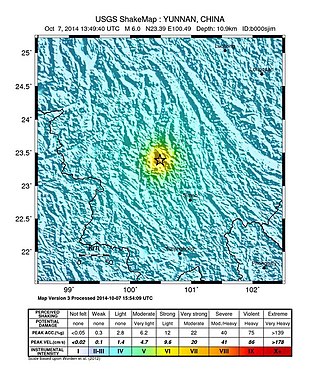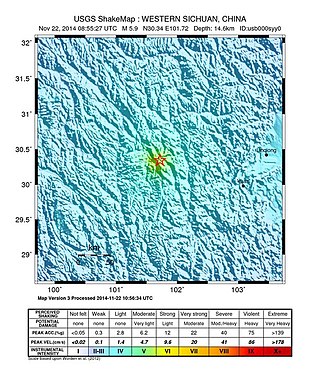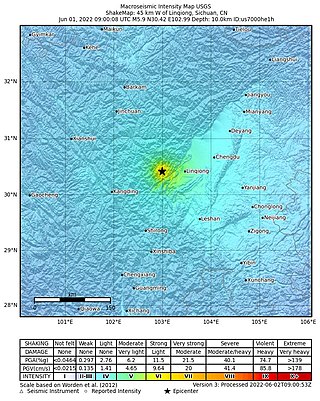
Yancheng, formerly known as Yandu, is a prefecture-level city in the eastern coastal Jiangsu province, People's Republic of China. As the city with the largest jurisdictional area in Jiangsu, Yancheng borders Lianyungang to the north, Huai'an to the west, Yangzhou and Taizhou to the southwest, Nantong to the south, and the Yellow Sea to the east. Formerly a county, the current Yancheng city was founded on January 18, 1983.

The 2008 Panzhihua earthquake struck southern Sichuan province, China on August 30 at with a surface-wave magnitude of 6.1, or 6.0 . It is also cited as the Renhe-Huili earthquake, especially in SCEA reports and early CEA reports. It was not an aftershock of the Sichuan earthquake that occurred several months prior. With more than 400 aftershocks, it caused over 40 deaths, the collapse of 10,000 homes and damage to other infrastructure in the provinces of Sichuan and Yunnan. The maximum liedu was VIII.
Jinhu County is under the administration of Huai'an, Jiangsu province, China with 289,456 inhabitants. It occupies the northwestern shores of and extends into Gaoyou Lake, bordering the prefecture-level cities of Yangzhou to the south and east, and Chuzhou (Anhui) to the southwest.

Yangzhou High School of Jiangsu Province is a high school in Yangzhou, Jiangsu, China. It grew out of Yidong School, which was established in 1902.
On 7 September 2012, a series of earthquakes occurred in Yiliang County, Zhaotong, Yunnan. The two main shocks occurred at 11:19 and 12:16 China Standard Time. The earthquakes left 81 people dead and 821 injured. According to the officials, at least 100,000 people were evacuated and more than 20,000 houses were damaged.
The 1998 Ninglang earthquake (1998年宁蒗地震) occurred on November 19 at . The epicenter was near the border between the provinces of Sichuan and Yunnan, China. The United States Geological Survey stated that the epicenter was located in the Sichuan Province, while the China Earthquake Data Center provided a different location in Lanniqing Township (烂泥箐乡), Ninglang, Yunnan Province. The magnitude of the earthquake was put at 6.2 and it caused five deaths, with 208 seriously injured in Yunnan and 20 people seriously injured in Sichuan. Building damage was reported in Ninglang, Yunnan and Yanyuan, Sichuan. A dammed lake was formed by a landslide in the Lanniqing Township.

The Lushan earthquake or Ya'an earthquake occurred at 08:02 Beijing Time on April 20, 2013. The epicenter was located in Lushan County, Ya'an, Sichuan, about 116 km (72 mi) from Chengdu along the Longmenshan Fault in the same province heavily impacted by the 2008 Sichuan earthquake. The magnitude of the earthquake was placed at Ms 7.0 by China Earthquake Data Center, Ms 7.0 by Russian Academy of Sciences, Mw 7.0 by Geoscience Australia, Mw 6.6 by the United States Geological Survey (USGS), Mw 6.6 by the European Alert System (EMSC) and Mj 6.9 by the Japan Meteorological Agency (JMA). 1,815 aftershocks have been recorded as of 00:00 (UTC+8h) April 22.
Gu Chao is a Chinese former professional footballer.

The 2014 Ludian earthquake struck Ludian County, Yunnan, China, with a moment magnitude of 6.1 on 3 August. The earthquake killed at least 615 people, injuring at least 2,400 others. At least 114 people remained missing. Over 12,000 houses collapsed and 30,000 were damaged. According to the United States Geological Survey, the earthquake occurred 29 km (18 mi) west-southwest of Zhaotong city at 16:30 local time (08:30 UTC).

The 2014 Jinggu earthquake occurred on October 7, 2014, at 21:49 (UTC+8).

The 2014 Kangding earthquake struck Kangding County, Garzê Tibetan Autonomous Prefecture, Sichuan, China, with a moment magnitude of 5.9 on 22 November. The earthquake killed five and injured 54 people.
Fei Gaoyun is a Chinese politician serving since 2018 as the Vice Governor of Jiangsu. Fei worked his way up the ranks from the grassroots level.
The 2017 Jiuzhaigou earthquake occurred on 8 August 2017, in Zhangzha Town, Jiuzhaigou County, Ngawa Prefecture, Sichuan Province, China. The earthquake was registered at 7.0 and killed at least 25 people in the mountainous region of northern Sichuan.

Xiju, also known as Wuxi opera, is a genre of opera which originated in the southern region of the Yangtze River Delta in China. It evolved from "Tanhuang" (滩簧), a folk opera art in the region of Wuxi and Changzhou of Jiangsu province. As one of the main local operas in Jiangsu Province, Wuxi opera has been reputed as "a piece of plum flower in Taihu Lake", a title given to the three major operas in East China, alongside Yue opera and Huangmei opera.

On May 21, 2021, a 6.1 magnitude earthquake struck the Dali City, Yunnan, China, at a depth of 10.0 km. Three people died during the quake, while another 32 were injured. The earthquake was referred by the Chinese media as the 5.21 earthquake or 2021 Yangbi earthquake.
The 2021 Maduo earthquake, also known as the 5.22 earthquake struck Madoi County in Qinghai Province, China, on 22 May at 02:04 local time. The earthquake had a moment magnitude and surface-wave magnitude of 7.4. Highway bridges, roads and walls collapsed as a result of the earthquake. According to an anonymous source, at least 20 people were killed, 300 were injured, and 13 were missing. Officials stated that there were no deaths but 19 people sustained minor injuries. It was the strongest in China since the 2008 Sichuan earthquake. It was assigned a maximum intensity of X in Machali, Maduo County on the China seismic intensity scale and Modified Mercalli intensity scale. This earthquake was preceded by another unrelated earthquake that occurred 5 hours earlier in Yunnan.
The 1937 Heze earthquakes struck the Mudan District in Shandong Province, China on July 31 and August 1 respectively. The moment magnitude 7.0 and 6.7 earthquakes were centered near the city of Heze. Although the total number of casualties has never been finalized, at least 3,252 people died and 12,701 were injured. The earthquakes also killed more than 6,000 livestock and destroyed 470,000 homes. Due to the outbreak of the Second Sino-Japanese War, rescue operations by the Chinese government were ineffective.

On June 1, 2022, a moment magnitude (Mw ) 5.8 or surface-wave magnitude (Ms ) 6.1 earthquake struck Lushan County in Ya'an, Sichuan Province, China. At least four people were killed and 42 were injured. The earthquake had a maximum intensity of VIII on the China seismic intensity scale, causing damage to many homes and triggering rockslides.

A 6.7 earthquake struck Luding County in Sichuan province, China on 5 September 2022 at 12:52:19 local time. The epicenter was located 226 km (140 mi) from Chengdu, or 43 km (27 mi) southeast of Kangding. Ninety-three people died, 424 were injured and 24 remained missing. More than 13,000 homes and other infrastructure were damaged or destroyed. It was the largest earthquake to strike the province since 2017.











